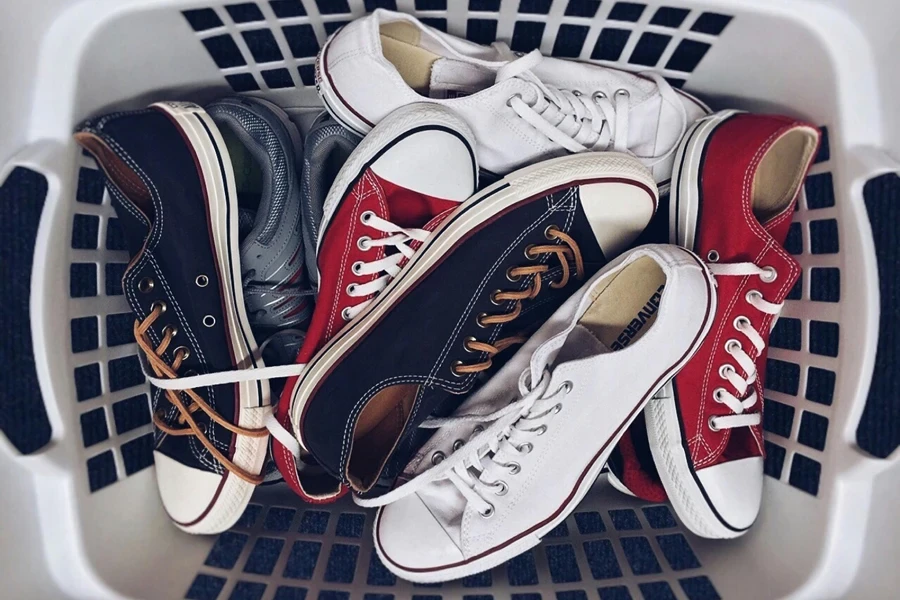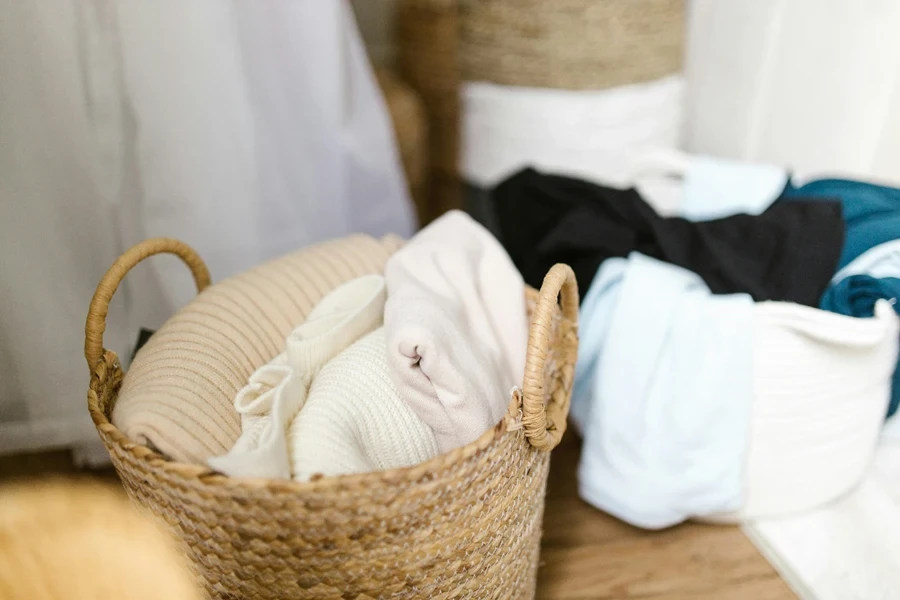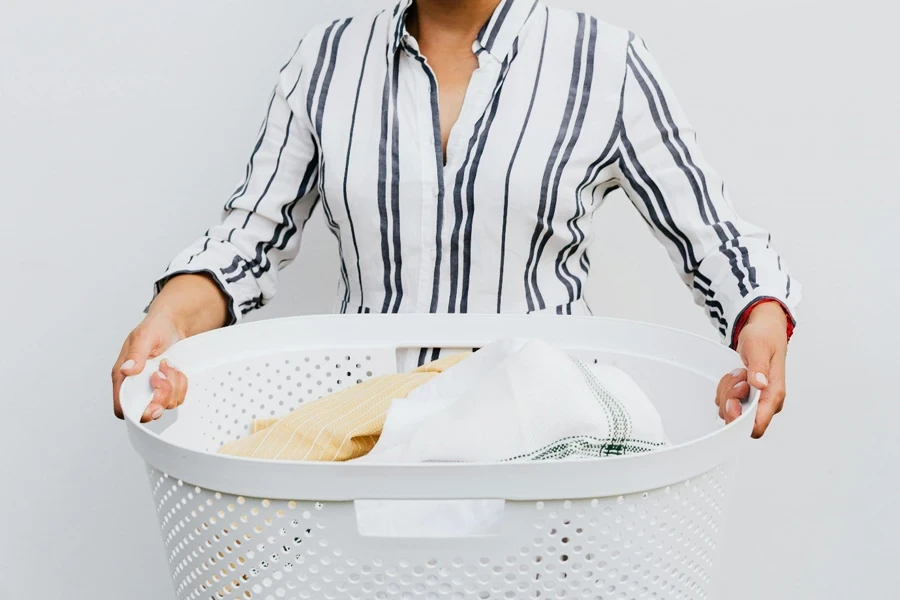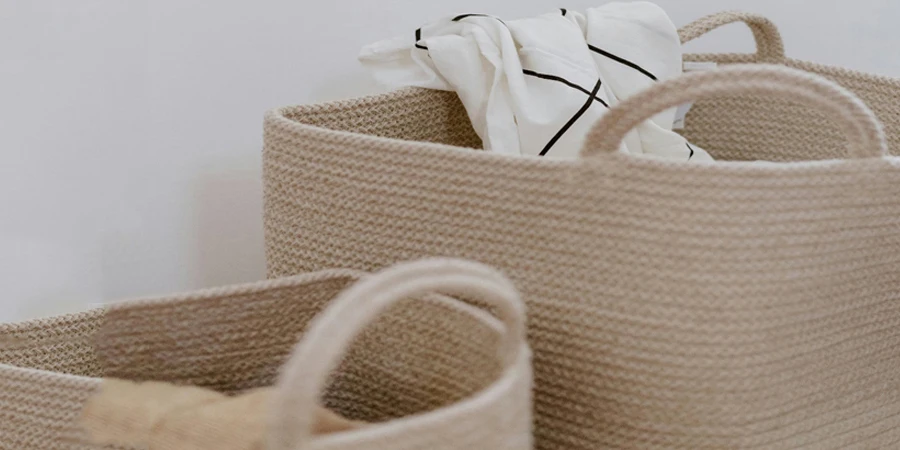Table of Contents
• Introduction
• Market overview
• Different types of laundry bags and baskets
• Things to consider when selecting products
• Conclusion
Introduction

Laundry bags and baskets are essential in both household and commercial settings, providing organization for dirty laundry and protection for delicate items while maintaining hygiene. The market for these products is expanding, driven by trends such as the demand for eco-friendly options. Various types, including hampers, baskets, and storage carts, cater to different needs and preferences. Key factors to consider when selecting these products include material, capacity, ventilation, and design. This guide offers an in-depth analysis to help businesses make informed decisions in choosing the ideal laundry solutions.
Market overview

Market scale and growth
The global laundry bag and basket market is poised for significant growth, with the market size expanding rapidly across various regions. The market is projected to grow at a compound annual growth rate (CAGR) of 6.5% from 2024 to 2032, driven by increasing consumer awareness about hygiene and the convenience of using laundry bags and baskets. North America, Europe, and Asia are expected to be the key regions, with North America leading the market due to high disposable incomes and lifestyle changes, followed closely by Europe and Asia.
Regional insights
Regional market shares are seeing substantial variations, with North America holding the largest share, primarily due to the prevalence of organized retail and a higher standard of living. Europe is also a significant market, driven by a strong focus on sustainable and eco-friendly products. The Asia-Pacific region is experiencing rapid growth, fueled by rising urbanization and a growing middle class with increasing purchasing power. The demand for eco-friendly and biodegradable laundry bags is a notable trend, as consumers become more environmentally conscious and seek sustainable alternatives to traditional plastic products.
Changing trends
Innovations in materials and design are also influencing market dynamics. The shift towards biodegradable and compostable materials, such as those offered by companies focusing on sustainable solutions, is gaining momentum. Additionally, advancements in design, such as collapsible and multi-functional laundry baskets, are appealing to consumers looking for space-saving and versatile options.
Different types of laundry bags and baskets

Laundry hampers
Laundry hampers are engineered for optimal convenience and functionality, featuring robust wheels and ergonomic handles for smooth mobility. Typically constructed from high-density polyethylene or reinforced canvas, these hampers can support large volumes, often exceeding 120 liters. They are equipped with reinforced stitching and heavy-duty zippers or drawstrings to ensure durability under frequent use. These features make hampers indispensable in settings with high laundry throughput, such as family households and communal living spaces.
Laundry baskets
Laundry baskets are commonly crafted from durable materials such as rattan, bamboo, or treated wood, which provide both aesthetic appeal and long-lasting performance. These baskets are often designed with ventilation holes or breathable weaves to prevent mold and mildew formation. Their capacity ranges from 40 to 100 liters, and they typically include ergonomic grips or handles to facilitate easy transportation. The structural integrity of these baskets ensures they can withstand repeated loading and unloading, making them ideal for daily use.
Laundry bags
Laundry bags, made from sturdy materials like polyester mesh or cotton, are designed for both portability and space efficiency. These bags can hold between 20 to 50 liters and often feature reinforced seams and drawstring closures to secure contents. Some advanced models include antibacterial coatings and water-resistant linings to protect against moisture and odor buildup. The foldable design allows them to be stored compactly when not in use, making them suitable for small apartments or dorm rooms.
Laundry storage carts
Laundry storage carts are designed with industrial-grade steel frames and heavy-duty caster wheels, providing a high-capacity solution for managing large laundry loads. These carts can hold up to 150 liters and include multiple compartments for sorting different types of laundry. Features often include removable mesh bags or liners that can be washed separately, as well as integrated shelves or racks for additional storage. The mobility and organization capabilities of these carts make them highly efficient in commercial settings like hotels and laundromats.
Laundry cabinets
Laundry cabinets integrate seamlessly into home decor while providing ample storage solutions. Typically made from good quality MDF or solid wood, these cabinets can include features like pull-out hampers, adjustable shelves, and moisture-resistant finishes. Capacities range from 60 to 150 liters, and designs often incorporate ventilation slats or integrated liners to promote airflow and prevent odor buildup. These cabinets not only enhance the aesthetic of laundry rooms but also offer practical storage for cleaning supplies and other household items.
Laundry organizers
Laundry organizers are versatile systems designed to streamline the laundry process. Constructed from materials such as powder-coated steel or high-strength plastic, they can include features like collapsible frames, multiple sorting compartments, and integrated drying racks. Capacities can vary, but many models accommodate up to 100 liters. Additional features may include wheels for mobility, hooks for hanging clothes, and breathable fabric sections to enhance air circulation. These organizers significantly improve efficiency by keeping laundry sorted and accessible, reducing the time and effort required for washing and drying.
Things to consider when selecting products

Material
Selecting the appropriate material for laundry bags and baskets involves understanding the technical specifications and performance characteristics of each option. Plastic baskets, often made from high-density polyethylene (HDPE), offer robustness and resistance to chemicals, making them suitable for heavy-duty use. They are lightweight and can withstand impact, but they may lack breathability. Wicker baskets, crafted from materials like rattan or bamboo, provide natural ventilation due to their woven structure. However, they require proper treatment to prevent mold and decay. Metal baskets, typically constructed from stainless steel or powder-coated iron, offer exceptional durability and can support heavy loads without deformation. They often include anti-rust coatings to enhance longevity. Mesh bags, composed of polyester or nylon, are designed for breathability and flexibility, ideal for delicate garments, and often feature reinforced seams and closures for added durability. Cotton and canvas bags, usually treated with water-resistant finishes, offer eco-friendliness and durability. These materials are washable and maintain structural integrity over time.
Capacity
The capacity of laundry bags and baskets should be selected based on specific needs, measured in liters. Small capacities (20-40 liters) are suitable for individuals or small apartments, efficiently holding a week’s worth of laundry. Medium capacities (40-80 liters) cater to average-sized households, offering sufficient space without becoming cumbersome. Large capacities (80-120 liters) are ideal for large families or commercial use, capable of handling substantial laundry volumes. Technical features like weight-bearing capacity, measured in kilograms, and dimensional stability, are crucial for ensuring the product can handle maximum loads without structural failure. It is also important to consider the spatial dimensions of the basket to ensure it fits within the intended storage area, with collapsible designs offering space-saving solutions when not in use.
Ventilation
Effective ventilation in laundry bags and baskets is critical for preventing the buildup of odors and maintaining hygiene. Designs with strategic perforations or mesh panels enhance airflow, facilitating the evaporation of moisture. Plastic baskets may feature engineered holes with specific diameters and placements to maximize air circulation while maintaining structural integrity. Wicker baskets naturally provide ventilation through their interwoven fibers, but they must be treated with anti-fungal agents to prevent mold growth. Mesh bags, with their open weave structure, offer superior breathability, allowing for optimal air exchange. In metal baskets, ventilation is often achieved through precisely cut patterns or integrated mesh inserts, ensuring that airflow is maintained while providing strength and durability.
Handles and portability
The design and construction of handles are paramount for the portability of laundry bags and baskets. Ergonomic handles made from materials like thermoplastic rubber (TPR) or reinforced nylon provide a comfortable grip and can withstand significant weight. Handles should be tested for tensile strength, ensuring they can support the maximum load without tearing. Some baskets feature integrated handles molded directly into the body, offering seamless strength distribution and reducing stress points. For enhanced portability, baskets with heavy-duty caster wheels allow for smooth movement across different surfaces. These wheels often include ball bearings and locking mechanisms to ensure stability and ease of use. Foldable designs, featuring collapsible frames made from lightweight aluminum or reinforced plastic, provide convenience and space efficiency.
Design and aesthetics
The design and aesthetics of laundry bags and baskets go beyond visual appeal, integrating functional elements that enhance usability. Divided baskets with multiple compartments, made from durable polymers or fabric panels, allow for efficient sorting of laundry types. Baskets on wheels often incorporate robust frames and smooth-rolling casters, facilitating easy transportation. Collapsible options, utilizing materials like high-strength steel frames and flexible fabric, provide practical storage solutions. The integration of modern design elements, such as sleek finishes, minimalistic shapes, and color options, ensures that these products complement various interior styles. Advanced features like moisture-resistant linings, antimicrobial coatings, and UV protection further enhance the product’s functionality and longevity, making them a valuable addition to any household or commercial setting.
Conclusion

Selecting the appropriate laundry bag or basket significantly enhances the efficiency and organization of any laundry routine, providing a balance of convenience, durability, and style. For both household and commercial applications, staying informed about market trends and understanding the technical specifications and selection criteria ensures that the chosen product meets specific needs and preferences. By considering factors such as material, capacity, ventilation, handles, and design, businesses can make well-informed decisions that optimize their laundry management processes.




